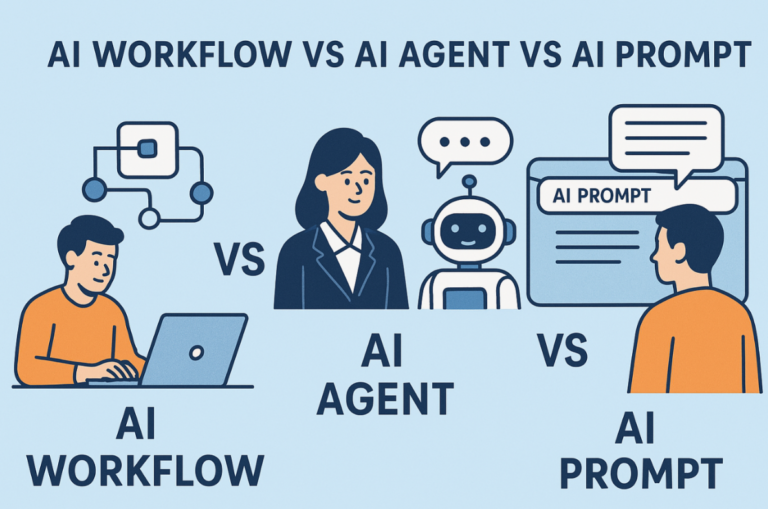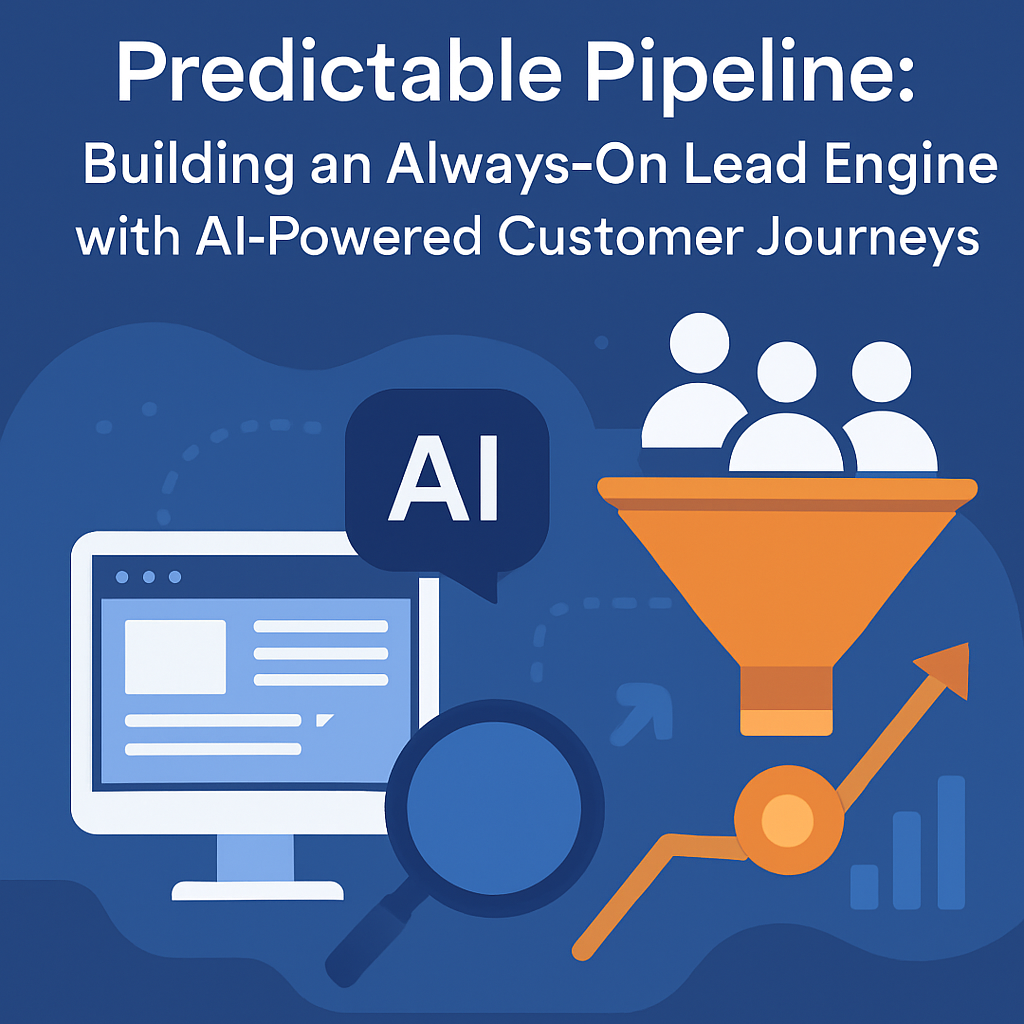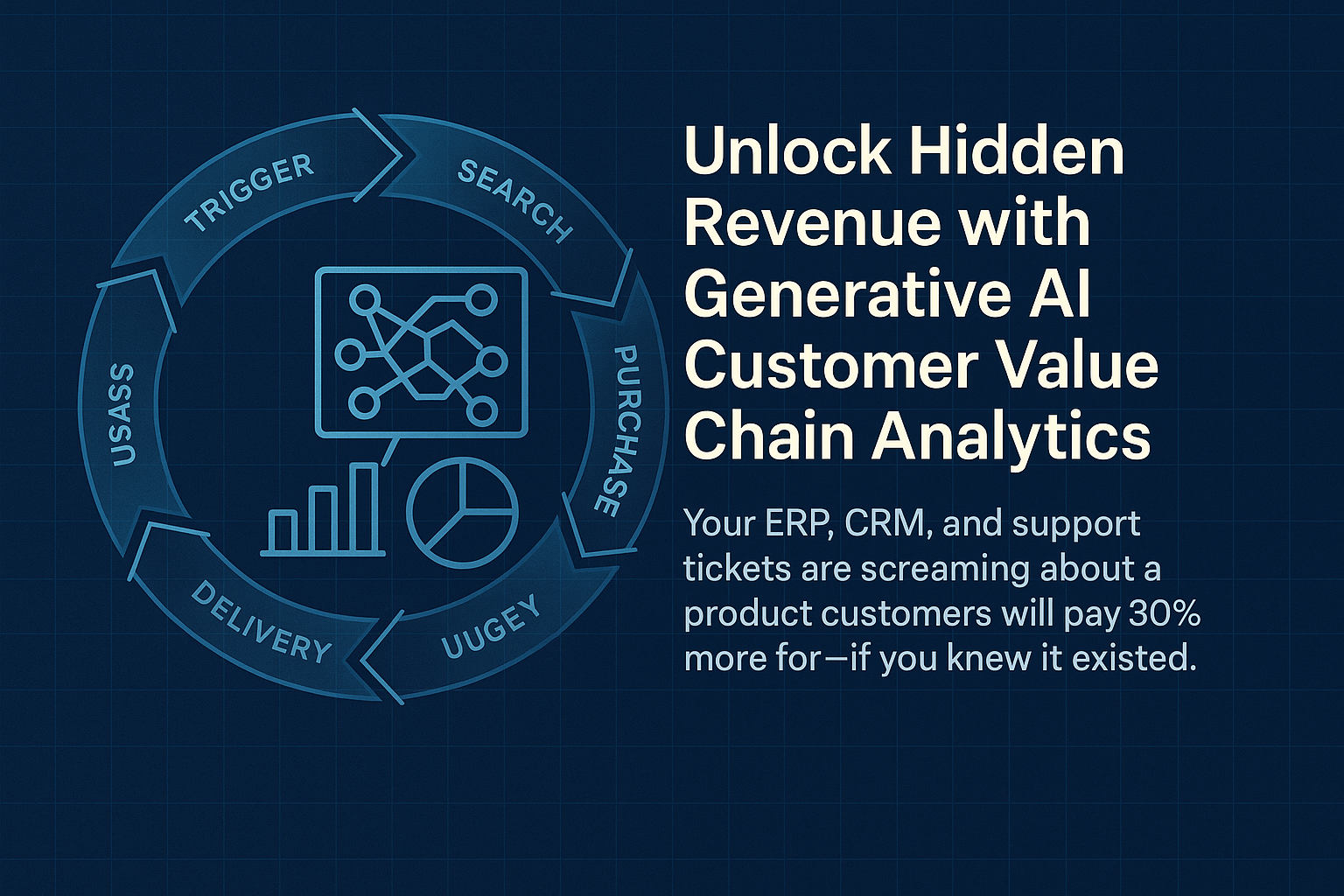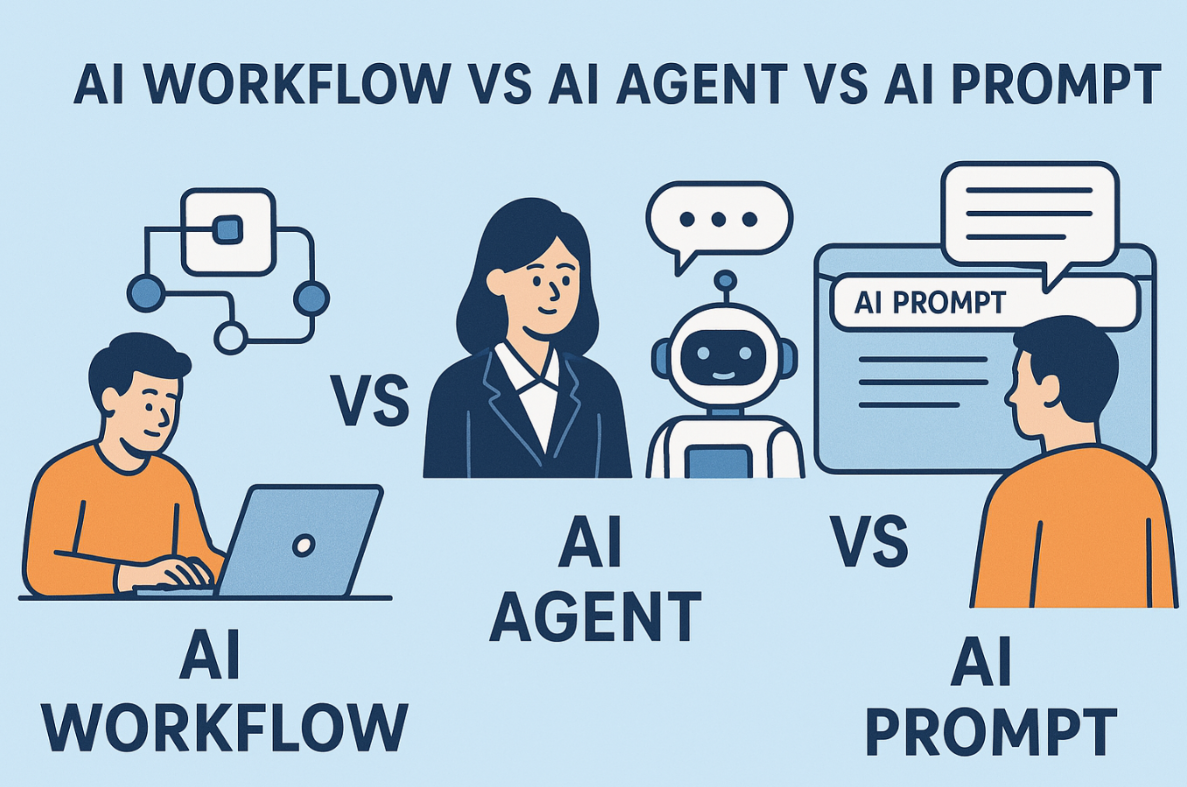Modern business leaders are under pressure to increase efficiency, improve customer engagement, and deliver measurable results—without increasing overhead. If you’re evaluating how artificial intelligence can help, you’re likely weighing the differences in using an AI Workflow vs AI Agent vs AI Prompt.
AI Workflow vs AI Agent vs AI Prompt: AI Workflows are automated sequences that execute business tasks like lead nurturing or invoice processing; AI Agents are autonomous tools that interact with users in real time, such as handling customer support chats; AI Prompts are one-off inputs used to generate specific outputs like content drafts or email replies.
- Decoding the AI Toolbox: Workflow, Agent, and Prompt Defined
- Use Cases That Matter: Real Business Applications
- AI Workflow vs AI Agent vs AI Prompt: Know When to Use What
- Implementation Speed: From Idea to Production
- How to Scale with Confidence Using the Right AI Tool
- Common Pitfalls to Avoid When Choosing an AI Solution
- Implement AI Into Your Business Today
Key Takeaways
- Start with AI Prompts to test ideas and get fast results.
- Use AI Workflows to automate proven, repeatable tasks.
- Deploy AI Agents only when complexity demands it.
- Choose the right solution based on business need, not hype.
Each type of solution—whether it’s an AI Workflow vs AI Agent vs AI Prompt—offers unique value depending on your goal, be it task automation, customer engagement, or content creation. This article will explain each one and when it’s best to use which. We are following a ‘simpler is better’ model. The faster you can get to production with AI, the faster you will see results..
Decoding the AI Toolbox: Workflow, Agent, and Prompt Defined
Before building any AI solution, it’s important to match the problem with the simplest tool that can solve it. AI tools differ not just in function but in complexity and deployment time. Here’s how to think about them:
- AI Prompt: Start here. Prompts are your entry point—simple, fast, and effective. You input a task, like “summarize this customer email,” and get a usable result. Great for testing use cases and immediate value delivery.
- AI Workflow: Once you know your task is repeatable, level up to workflows. These handle multi-step operations like lead capture → follow-up → CRM update. They’re ideal for scaling routine tasks without human oversight.
- AI Agent: The final step. Use agents when you need a dynamic system that can manage complex, real-time interactions across multiple platforms—like a virtual assistant that books appointments and updates systems.
Understanding these layers through AI Workflow vs AI Agent vs AI Prompt helps avoid overbuilding, saving time and money.
Use Cases That Matter: Real Business Applications
Let’s apply the “simplest first” principle with real-world examples:
- Start with a Prompt: A small manufacturer uses AI prompts to generate product descriptions. No automation, just fast content. This validates AI’s usefulness before further investment.
- Scale to a Workflow: Seeing value, the same company automates inbound quote requests. Now, leads trigger a workflow: send auto-replies, enter CRM, notify sales.
- Graduate to an Agent: Only after proving consistent traffic and inquiries, they implement a chatbot that qualifies leads and answers basic questions 24/7.
Following this ladder of sophistication ensures AI supports—not overwhelms—your team.
AI Workflow vs AI Agent vs AI Prompt: Know When to Use What
This is where the decision becomes strategic. Choosing between an AI Workflow vs AI Agent vs AI Prompt depends on your business goal. Here is how you identify processes for automation workflows, agents and prompts.
- Choose AI Workflows when you want to automate repetitive tasks at scale. Ideal for backend operations, lead management, or invoicing. Start with well known documented processes. If a mistake is made it is not costly to the business.
- Choose AI Agents when user interaction and real-time support are essential. Perfect for industries that deal with appointment booking, customer service, or customer onboarding. Agents are also great for answering FAQ’s directly or providing basic guidance.
- Choose AI Prompts when you need fast content generation or internal support—like drafting a blog outline, summarizing a client meeting, or scripting a cold call intro. You may find that you need to use the prompt over and over again or decide to delegate the task. This is where creating a prompt library comes in handy.
The key is matching the complexity of your need with the right level of AI involvement. Start small, then layer on sophistication as you go.
Implementation Speed: From Idea to Production
Time-to-deployment is often the deciding factor. Businesses want quick wins without draining internal resources.
- Prompts are immediate—no setup, just results. Great for lean teams who need creative or administrative lift fast. Easy to delegate via a prompt library once the prompt has been refined.
- Workflows require some configuration but are typically ready in days if the process is already defined.
- Agents take more time due to material gathering, prompt creation, logic, and training—but they deliver high value in customer-facing roles.
Speed matters. If your need is urgent, the AI Workflow vs AI Agent vs AI Prompt framework can help you prioritize—prompts and workflows are your gateway to immediate ROI, with agents being a solid next step.
How to Scale with Confidence Using the Right AI Tool
Starting small isn’t just smart—it’s sustainable. Instead of overinvesting in one big solution, scale your AI capabilities as business needs evolve.
- Use AI Prompts to test messaging and reduce internal workload.
- Build AI Workflows to free up time by automating low-value but necessary tasks.
- Deploy AI Agents when you’re ready for consistent, always-on support.
The secret isn’t choosing one over the other—it’s knowing how to integrate AI Workflow vs AI Agent vs AI Prompt in phases to support long-term growth without overwhelming your team. Only move to the next step if you think additional efficiencies and accuracy can be gained.
Common Pitfalls to Avoid When Choosing an AI Solution
Even the best tools can fail when used incorrectly. Here are common traps to sidestep:
- Overengineering: Don’t start with a complex agent when a simple prompt would solve the problem faster.
- Lack of clarity: Vague goals lead to poor implementations. Be specific about what the AI should do.
- Neglecting human oversight: AI is a tool, not a replacement. Regular audits and improvements are necessary. For critical tasks that must have a high level of accuracy there should always be a human in the loop. The team will go from creators to reviewers and editors.
Avoid these, and AI becomes a powerful business partner.
Implement AI Into Your Business Today
Adopting the right AI strategy doesn’t have to be overwhelming. At Inkyma, we guide businesses through the process of evaluating, choosing, and implementing AI solutions that align with their goals and internal capabilities. Whether you’re exploring AI Workflows, testing AI Prompts, or considering AI Agents, we’re here to help you get to production faster—with less risk.
Let’s make AI work for your business. Schedule a Strategy Session with Inkyma to start mapping out the best approach for you.
Can small businesses afford to implement AI Workflows or Agents?
Yes, modern AI solutions have become more accessible and cost-effective for small to mid-sized businesses. Tools can be scaled to fit budget and scope, starting with simple prompts or workflows and evolving into more advanced agents as the business grows.
Can combining AI prompts, workflows, and agents provide a more effective solution for my business?
Yes, integrating AI prompts, workflows, and agents can create a comprehensive AI ecosystem tailored to your business needs. Begin with prompts to address immediate, simple tasks. As you identify patterns and repetitive processes, develop workflows to automate these efficiently. For areas requiring complex decision-making and real-time interaction, deploy AI agents. This layered approach ensures that each AI component complements the others, leading to a cohesive and effective solution that evolves with your business.
How can I avoid overcomplicating AI implementation in my business operations?
To prevent overcomplicating AI implementation, adopt a progressive approach:
Begin with AI prompts: Use simple prompts to handle straightforward tasks and assess AI’s potential benefits.
Transition to AI workflows: Once you’ve identified repetitive tasks that can be automated, develop workflows to streamline these processes.
Implement AI agents when necessary: Only introduce AI agents for tasks that require complex decision-making and adaptability. Check Enkrypt AI.
This method allows you to scale AI solutions in alignment with your business growth, ensuring that each implementation is purposeful and manageable.












